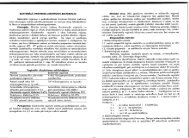PHYSICS
n - susliks.lv
n - susliks.lv
- No tags were found...
Create successful ePaper yourself
Turn your PDF publications into a flip-book with our unique Google optimized e-Paper software.
(or wavelength). A typical value for the monochromaticity of a<br />
He-Ne laser is approximately L1v/v = 10- 12 -10- 13 •<br />
Coherence is the coordinated movement of several wave<br />
processes in space and time. We can distinguish two types of<br />
coherence: temporal coherence - when at a given point in space<br />
there is a constant phase difference between the amplitude of the<br />
wave at two successive instances in time; and spatial coherence <br />
which is characterised with a constant time-independent phase<br />
difference for amplitude at two different points.<br />
For example, the degree of temporal coherence for a He-Ne<br />
laser is t = 1/ L1v = 10- 4 s; for a ruby laser it is r = 10- 8 s (here<br />
L1v is a bandwidth of the laser line).<br />
Directionality is determined by the angular distribution of the<br />
laser beam. This property is the direct result of the propagation of<br />
two light waves in the optical cavity; only waves that propagate<br />
normally to the resonator mirrors partici pate in the formation of<br />
the laser beam. The angular distribution, or divergence, is defined<br />
as:<br />
(] = 1.22}"/D (21.17)<br />
where D is the beam diameter and A is the wavelength.<br />
The divergence of gas lasers is about 10/; solid-state lasers <br />
10/ - 40/; semiconductor lasers - about 3°. For example, the<br />
beam of a He-Ne laser with the diameter 1 mm has an angular<br />
divergence about 10- 3 radians. Therefore if the surface of the<br />
moon was illuminated from earth with a laser spot, the diameter<br />
of the spot would be about 400 km.<br />
Brightness of the source of electromagnetic waves is defined as<br />
the power of radiation that is emitted from the unit at the source<br />
surface through the unit solid angle. The solid angle is<br />
proportional to f) 2 (where f) is beam divergence). This is why laser<br />
beams with even a small divergence are several orders of<br />
magnitude higher in brightness than traditional sources of light.<br />
For example, the brightness of a high-pressure mercury lamp<br />
(P = 100 W) is five orders of magnitude less than the brightness<br />
of a He-Ne laser (P = 1 mW).<br />
Applications of Lasers. Laser sources make it possible to obtain<br />
information that is difficult or impossible to obtain with conventional<br />
sources. Lasers are extremely useful due to their intensity,<br />
158<br />
amount of monochromatic radiation, and the coherent nature of<br />
their output. They can be successfully applied to diagnostics,<br />
therapy, and surgery due to their unique properties - spatial and<br />
temporal coherence, frequency and intensity range, monochromaticity,<br />
and degree of control over the focal area and beam<br />
length.<br />
Optical and laser spectroscopy methods can be utilized for the<br />
analysis of different parameters. For example in cattle-breeding,<br />
the diameter, density, orientation and pigmentation of animal<br />
hair can be quantitative determination using laser diffractometry,<br />
microfluorometry, and microphotometry. Likewise, measurement<br />
of light scattering can be used to investigate the size distribution<br />
of milk particles. Using laser Doppler spectroscopy, dynamic parameters<br />
of spermatozoa and a precise estimation of sperm motility<br />
can be determined.<br />
Laser-induced fluorescence of chlorophyll in vivo can be used<br />
as a nondestructive, fast and precise estimation of the health status<br />
of plants and the effect of different stresses.<br />
Lasers can be used for remote sensing to monitor various<br />
conditions of the atmosphere, such as the amount of aerosols and<br />
gaseous air pollutants (e.g., N0 2, S02' and 0) or the determination<br />
of gases in smoke plumes from a distance of several hundred<br />
meters. Likewise, laser remote sensing methods are useful for<br />
meteorological applications such as the measurement of cloud<br />
characteristics, preci pitation, humidity, wind, and temperature.<br />
22. PHYSIOLOGICAL OPTICS<br />
iSOOJllII~~!'lj~l\I:;i~;::W-'.:$!'ii!li"~'~'('""":;~~~~~<br />
22.1. THE EYE AS AN OPTICAL SYSTEM<br />
Mammals. The eye is an extremely complex part of the body. Fig.<br />
22.1 shows the essential parts of the eye. The front is covered by a<br />
transparent membrane called the cornea. Behind the cornea is<br />
clear liquid region (the aqueous humor), a variable aperture (the<br />
iris and pupil), and a crystalline lens. The iris, which is the colored<br />
portion of the eye, is a muscular diaphragm that controls the size<br />
of the pupil. The iris regulates the amount of light entering the<br />
eye by dilating the pupil when the light intensity is low and<br />
contracting the pupil when high. Light entering the eye is focused<br />
159






